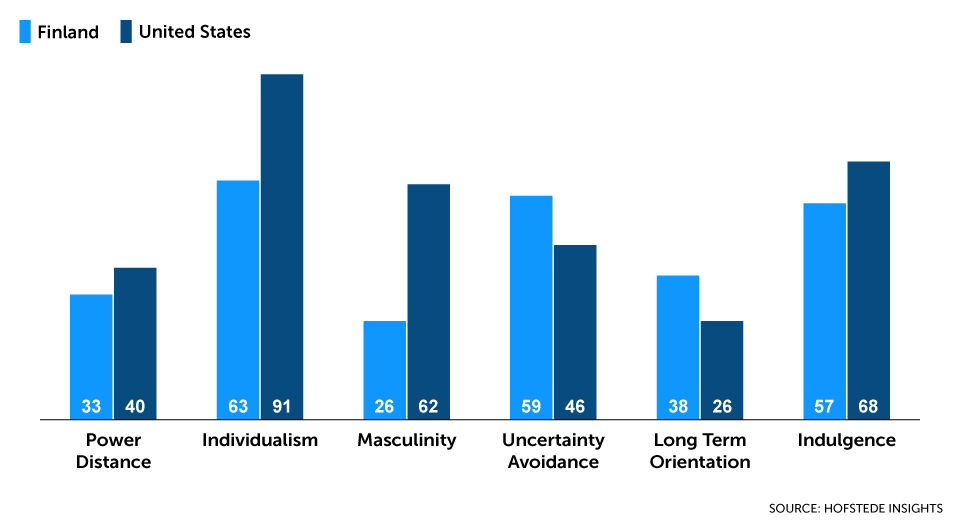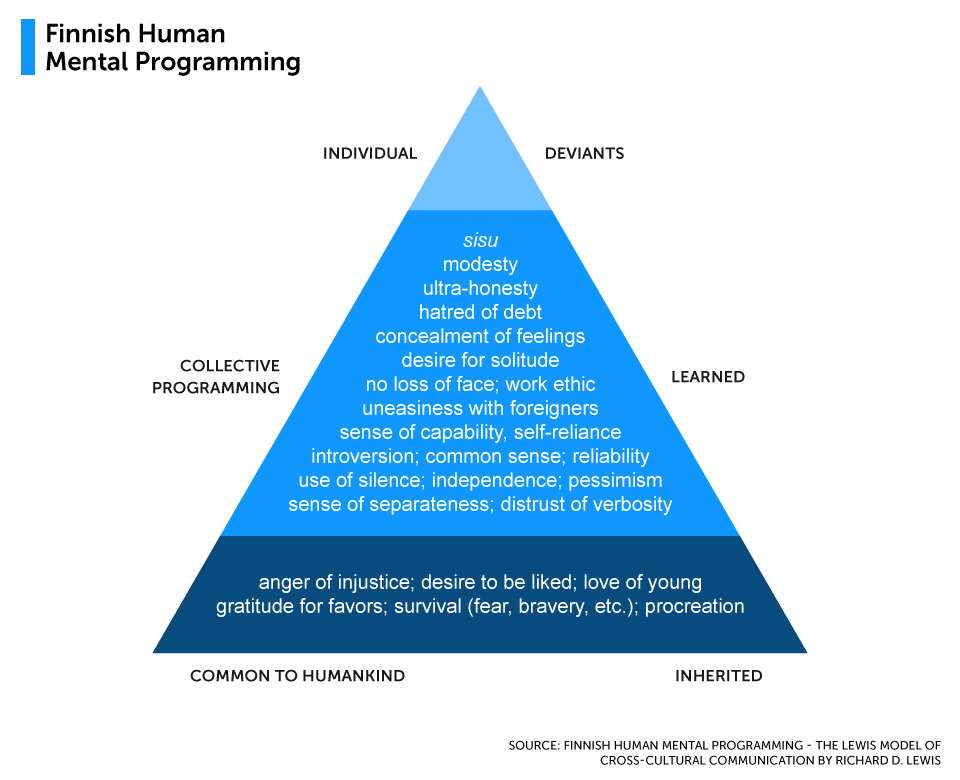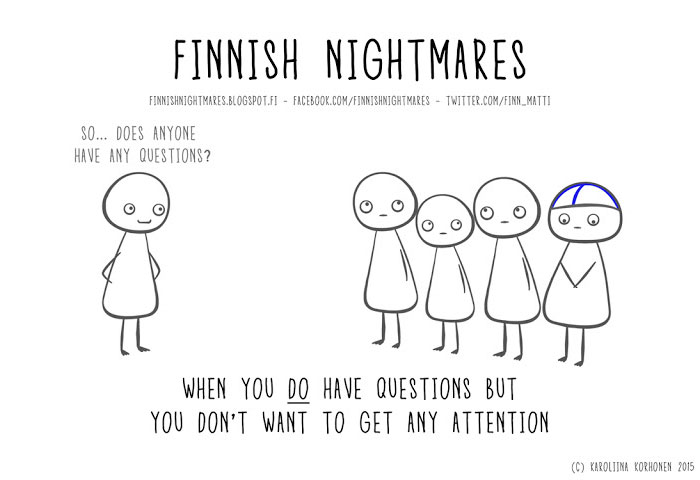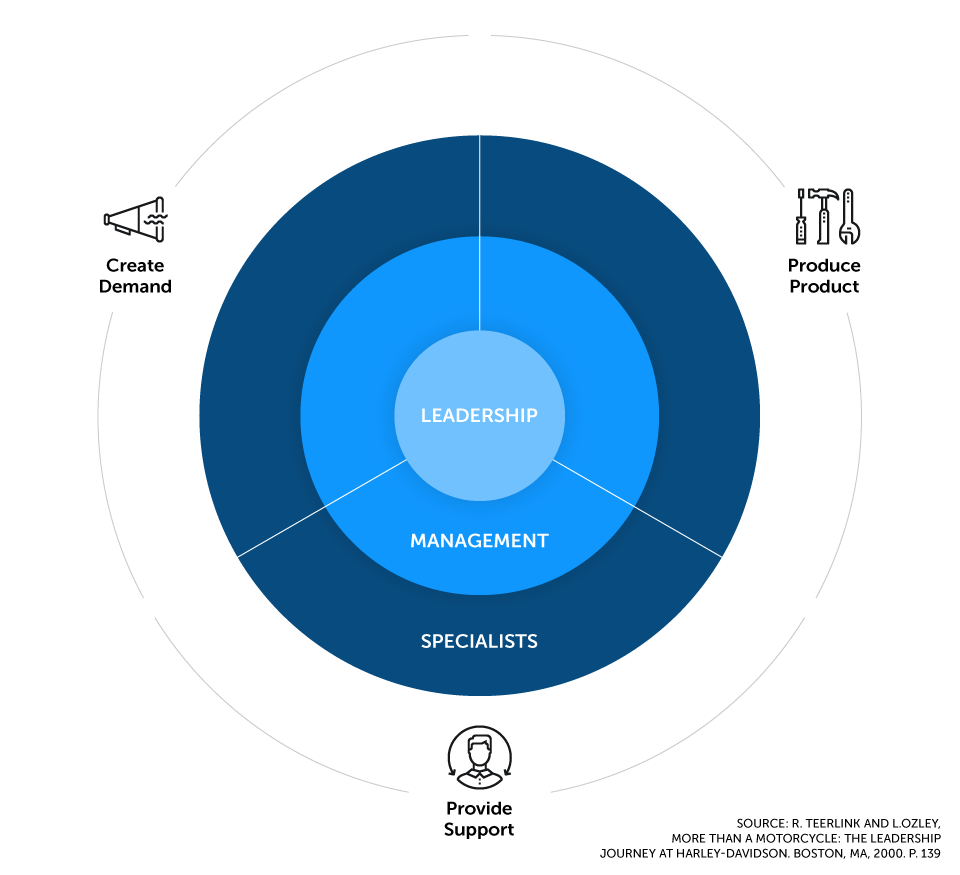A guide to Finnish work culture
A cross-cultural look at American vs Finnish work culture from one Californian working at Valamis, a digital learning company headquartered in Finland.

A cross-cultural examination of American and Finnish work culture from one Californian working at Valamis, a digital learning company headquartered in Finland.
It is no surprise that Finland, a country ranked as the happiest country in the world, routinely dominating the education sphere, in addition to endless accolades for gender equality, innovation and transparency — would also be winning in the workplace.
I have to say, the Finns are doing something right. Actually, a lot of things right. I work with a predominantly Finnish team at Valamis, and a majority of the leadership team is based in Finland. I have found working for a Finnish company to be in stark contrast with my experience working with American firms. Although the World Economic Forum ranks the United States as the #1 most globally competitive nation in the world, Finland, a much smaller nation, outranks the United States in many areas, all whilst working fewer hours. The World Economic Forum report found that overall, ranking higher in competitiveness is typically associated with less working time and more leisure time, suggesting that productivity is increased not by working more hours, but by using working hours more efficiently.
The United States’ working culture, impressive entrepreneurial spirit, and concept of the American Dream are fueled by terms like “hustle” and “grind” — words that can invariably mean substituting well-being in pursuit of economic prosperity. I have learned an enormous amount from working at a Finnish company, namely, the power of efficiency. The power of efficiency comes from a variety of factors, like the cultural differences that may attribute to a majority nation of happy, educated, healthy, and productive Finns.
Finnish Culture According to Gerard Hofstede
Gerard Hendrik Hofstede is a Dutch social psychologist, former IBM employee, and one of the leading academics on culture. His most notable work has been in developing cultural dimensions theory, where he compares national cultures along six dimensions: Power Distance, Individualism, Uncertainty Avoidance, Masculinity, Long Term Orientation, and Indulgence (vs. Restraint).
Built on the approach developed by Professor Hofstede, Hofstede Insights has found that Finland is considered a Normative-thinking, Egalitarian, Individualist, Feminine, Indulgent country with a preference for avoiding uncertainty.
Hofstede Insights – Finland
Power distance
- Independent
- Hierarchy only for convenience
- Equal rights
- Superiors accessible
- Management facilitates and empowers
- Power is decentralized
- Employees expect to be consulted
- Control is disliked
- Attitude towards managers are informal and on a first name basis
- Communication is direct and participative
Individualism
- Individualist society
- High preference for a loosely-knit social framework in which individuals are expected to take care of themselves and their immediate families only
Masculinity
- Feminine society; In Feminine countries, the focus is on “working in order to live” rather than living to work
- Managers strive for consensus
- People value equality, solidarity, and quality in their working lives
- Conflicts are resolved by compromise and negotiation
- Incentives such as free time and flexibility are favored
- Focus is on well-being
- Status is not shown
- An effective manager is a supportive one, and decision making is achieved through involvement
Uncertainty avoidance
- High preference for avoiding uncertainty
- Time is money
- People have an inner urge to be busy and work hard
- Precision and punctuality are the norms
Long term orientation
- Finnish culture can be classified as normative
- A strong concern with establishing the absolute Truth; they are normative in their thinking
- Exhibit great respect for traditions
Indulgence
- Exhibit a willingness to realize their impulses and desires with regard to enjoying life and having fun
- Possess a positive attitude and have a tendency towards optimism
- Place a higher degree of importance on leisure time
- Act as they please and spend money as they wish
Working to live vs. Living to work
When you compare Finland with the United States using Hofstede’s dimensions, there is very little disparity in many of the categories, with the largest gap coming from the dimension of Masculinity.

The United States ranks as a “Masculine society,” which is distinguished as a society where the main motivating factor is ‘wanting to be the best’ (Masculine). In contrast, Finland ranks as “Feminine,” which is described as a society where you ‘like what you do.’ The nomenclature “Masculine” and “Feminine” can be seen as misnomers, but were defined by Hofstede to decipher between societies with more (or less) distinct gender roles.
Other characteristics of being a feminine society, listed in the graph above, include equality, well-being, and flexibility. These cultural qualities continue to resonate in my working life at a Finnish company, and I can condense them down into 5 key findings:
1. Talk is cheap (and unproductive)
“Your actions speak so loudly, I can not hear what you are saying.” — Ralph Waldo Emerson
Some of my coworkers in Finland are most likely cringing as they read my laudatory language, which is in direct contradiction to their humble values — a few might even respond in different variations of something like, ‘we aren’t doing things right, a lot of people are just doing things differently,’ in order to downplay the praise.
In Finnish work culture, talk is cheap. Working with the Finns, you realize that concise communication with genuine intention is collectively programmed in the culture.

If a Finn tells you their product is the best, are they really a Finn? Even if their product is the best, there is a very rare possibility a Finn would ever tell you that. Finnish people are extremely modest, and unforgivingly honest, which makes for a transparent work culture, that cuts through the noise of verbosity and wasted time.

The creator of “Finnish Nightmares,” Karoliina Korhonen, describes the main character as “a stereotypical Finn who appreciates peace, quiet and personal space.”
2. Diminish the Barriers of Hierarchy for a Culture of Innovation
Layers of time-consuming micromanagement and approval processes impede productivity and organizational agility. If Finns say they’re going to do something, they do it. This collective agreement and trust allow for a high level of autonomy and low level of bureaucracy to ensue.
Finnish egalitarianism doesn’t comply with traditional barriers of hierarchy, making it easier to communicate with superiors, allowing for full transparency. In order to have ideas rise from all areas of the company, Valamis’ work culture has a relatively flat hierarchy, a circular organizational structure stopping just short of a holacracy. In circular organizations, the leaders or executives are at the center of the organization, spreading their vision outward.

Valamis is overflowing with new ideas, insight, and constructive feedback to make things better; a culture that only works when transparency, egalitarianism, and purpose coexist. When people listen to others, feel valued, and believed in, they are driven to do more. Motivation, in both its intrinsic and extrinsic forms, is contagious.
The value employees get from working at an interdependent company where their work can make an impact, engenders purpose. Purpose in the workplace is directly linked to company loyalty. Millennials are 5.3x more likely to stay at a company when they have a strong connection to their employer’s purpose, and non-Millennials are 2.3x more likely to stay. Investing in talent is easy, but developing employee purpose and employer loyalty is the hard part.
3. Support Workforce Development & Well-being
Companies like Valamis invest in employees; education, development, and wellbeing. Working at a Finnish company focused on upskilling the workforce, I have had ample opportunities to develop professionally, which is a contributing factor for many in regards to company loyalty. Millennials are often seen as notorious “job-hoppers” but on the same accord, Millennials are observed as valuing professional development. Establishing a lifelong learning attitude in the workplace helps employees to find purpose, regardless of the changing roles and needs in the workplace. Offering employees options to pursue learning and development, employers can reskill their workforce and build employer loyalty. Also, new knowledge can spring about new ideas.
An Example of a Marketer’s Valamis Professional Development
![]() Mentorship
Mentorship
- Mentored in data science by a subject matter expert at my company (Thank you Antti).
- Leadership is constantly sharing their expertise in emerging technology, strategy, and other topics.
- Can request meetings with leadership any time.
![]() Cross-Cultural Experiences
Cross-Cultural Experiences
- Traveled globally for development days in Finland and a strategy workshop in London as well as a daily working basis of cross-cultural, international collaboration.
- Ability to relocate to other offices.
![]() Training
Training
- Learned on our Learning Experience Platform (LXP); our company platform itself is a tool to curate learning for our professional development.
- Went to HubSpot’s Marketing and Sales Alignment training and Professional development courses at CIC with Kit Pang.
![]() Learning Resources
Learning Resources
- Endlessly read and listen to podcasts thanks to our Amazon Kindle & Audible Unlimited Benefit.
- Valamis invests in other resources upon request like books, classes, events.
- Customer research cafés: Having a coffee with colleagues while discussing an idea that will benefit the whole company.
- Webinars and training held by employees and used within the Valamis LXP.
![]() Autonomy
Autonomy
- Ability to Implement ideas. This has been instrumental for me in the workplace. It is truly empowering to have a company that listens to your ideas, no matter how crazy. To be heard and to contribute creates an ecosystem of meaningful work. Everyone is valued and has a purpose.
4. Balance Work and Life like the Finns
Jack Ma, the Jeff Bezos of China, Founder of Alibaba, has stated that he supports a “996” work culture, which implies working from 9 AM until 9 PM, 6 days a week. However, after about 48 hours a week, a worker’s output drops sharply, according to a Stanford study. While there may be an initial burst of activity from overworking, people who work more than 55 hours a week perform worse than those who go home at a normal hour and get some rest.
I wonder if you sent an email in July to every working citizen in Finland, what percent would be returned back with an out-of-the-office message. The Finns take their summer holidays seriously. In the summer, after enduring long bouts of cold weather and darkness in winter, the Finns enjoy their summers.
I did not know what work-life balance meant until working for a Finnish company. Striking a balance between work and life goes hand-in-hand with efficiency. When you are efficient in the workplace, you can leave (most days) having put in your hours, put them to good use and can go home without the boundaries of work melting into your personal life. There are days when even with the utmost efficiency, you cannot finish all of your tasks — but there is an understanding that if you keep working, your productivity and efficiency will decrease, and your lust for life and work will also disintegrate. Of course there are days when work-life balance may not occur due to the nature and urgency of a project, but even so, there is a belief that hard work will result in a well-deserved summer holiday.
The famous Finnish work-life balance can often be misinterpreted as not working as much as Americans, which is true, but it is more than that. Above all else, there is a value of time; your time at work, your time with family and friends, your time outdoors, and your time living. Finnish organizations don’t profit to profit or grow to grow; they put people first, so profit and growth become a side effect.
5. Don’t Sweat the small stuff, unless in a Sauna
Finnish work culture has personally helped me realize what my output can be without the barriers of micromanagement and 80 hour work weeks.
Without the constant stream of feedback from a debilitating micromanagement culture, I have learned to not sweat the small stuff, as much as I once did. I still worry, but I have realized not only is it unproductive, but it can be very counterproductive. A level of autonomy gives you the space to breathe and come up with new ideas, and also the courage to share them.
I have also found, a culture of transparency and honesty has been refreshing for not only me but for customers as well. Customers prefer realistic expectations over excessive superlatives, overpromising, and buzzwords. ‘The (insert superlative) company in (insert topic),” has saturated the internet, and at the end of the day, being the best really depends on the individual situation and perspective.
Valamis, albeit Finnish-based, has expanded to countries around the world. As the company continues to grow, it will absorb more and more elements from other cultures, and I have personally enjoyed the mix of American-Finnish business culture, here in Boston. I believe every business, no matter where they are, would benefit from absorbing elements of Finnish culture into their work culture.
**This article is not intended to make a broad generalization nor stereotype an entire country’s population, but rather note the differences experienced working for a company comprised of many nationalities, with its roots in Finland and Finnish culture.**




